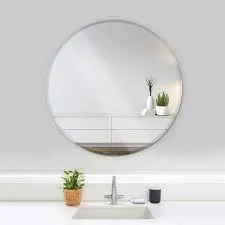

The Fascinating World of Back-Silvered Mirrors
Mirrors have been essential tools throughout history, serving both practical and decorative purposes. Among the various types of mirrors, back-silvered mirrors hold a unique fascination due to their innovative manufacturing technique and significant cultural impact. Understanding the back-silvered mirror requires delving into its origins, production methods, and the roles it plays in contemporary society.
The back-silvering technique, also known as silvering, involves placing a reflective layer of silver at the back of a glass sheet. This method was developed in the early 19th century, primarily credited to the French chemist and glassmaker, Dominique François Arago. Before this technique, most mirrors were made using polished metal surfaces, which resulted in less clarity and a more distorted reflection. The introduction of back-silvering marked a revolution in mirror production, allowing for clearer, more reliable images while enhancing aesthetic appeal.
The Fascinating World of Back-Silvered Mirrors
The quality of a back-silvered mirror can be attributed to the precision involved in both the glass and silver application processes. Each step requires meticulous attention to detail, ensuring a flawless reflective surface. Once completed, these mirrors exhibit remarkable qualities, including bright reflectivity, minimal distortion, and longevity. This combination of factors has made back-silvered mirrors a favorite choice in homes, art installations, and public spaces.

In everyday life, back-silvered mirrors can be found in a multitude of settings. From dressing rooms and bathrooms to art galleries and reflecting pools, these mirrors serve not only as functional objects but also as decorative elements. Their ability to enhance light and space has led to their incorporation in interior design, where they can create illusions of depth and openness in small rooms. In art, artists have utilized mirrors to explore themes of identity, perception, and reality, utilizing the reflection to engage viewers in a dialogue about self and environment.
Culturally, mirrors have long been imbued with symbolism and significance. They are often seen as tools for self-examination, both literally and metaphorically. In literature and folklore, mirrors are used as motifs to represent truth, beauty, and the passage of time. The back-silvered mirror, with its clear and true reflection, can evoke feelings of introspection, prompting viewers to confront their perceptions of themselves and the world around them.
In the age of technology and advanced manufacturing, the back-silvered mirror remains a timeless object. Despite the rise of digital screens and virtual reflections, the tactile and visual qualities of a well-made mirror continue to captivate us. There is something undeniably magical about looking into a surface that not only reflects our image but also refracts our perception of reality.
In conclusion, back-silvered mirrors are much more than mere pieces of glass; they are complex artifacts that combine art, science, and symbolism. Their history reflects technological advancement, while their continued popularity underscores their enduring appeal in a modern world. Whether as tools for personal grooming or elements of artistic expression, back-silvered mirrors will continue to enchant and inspire for generations to come.